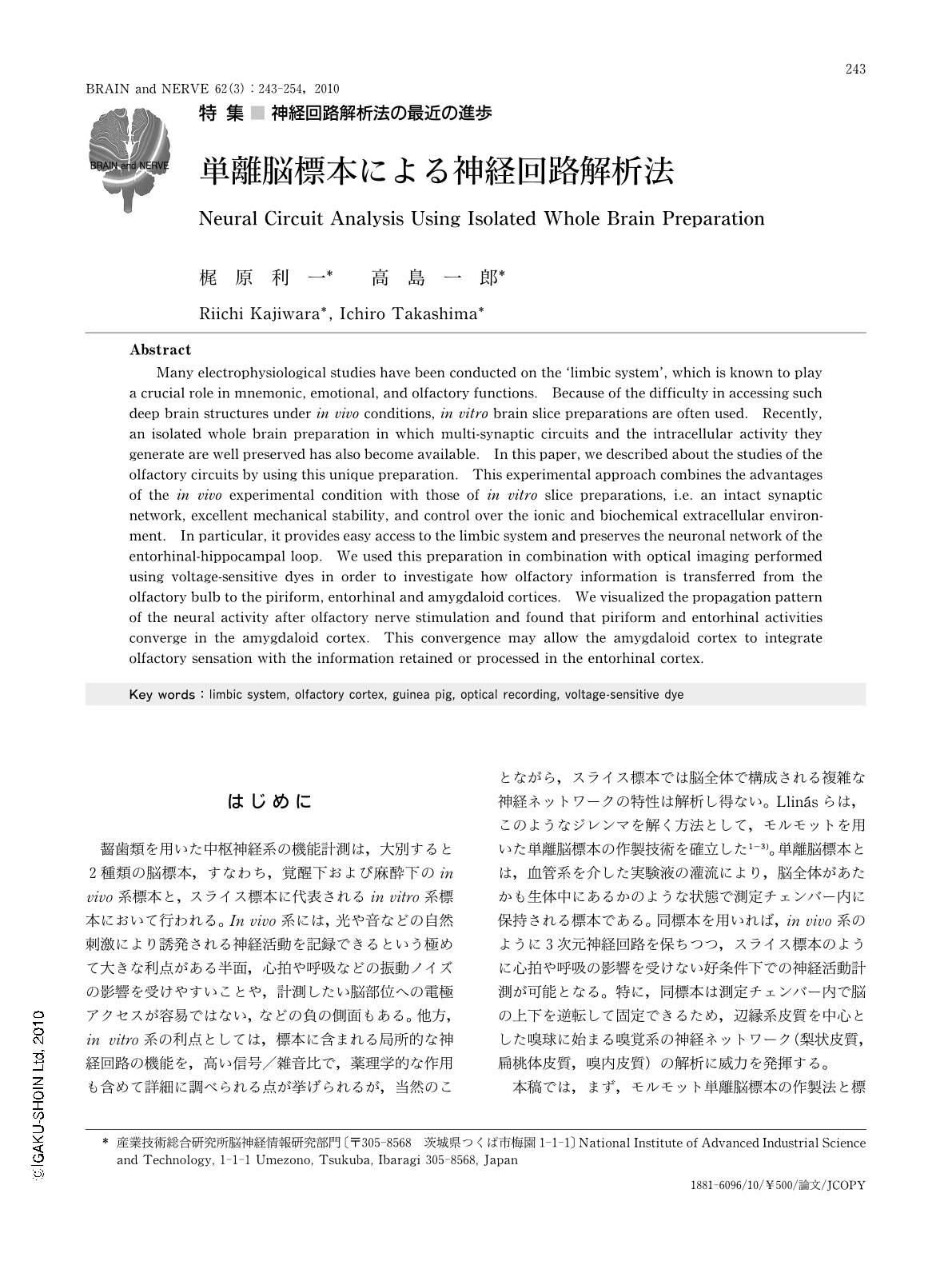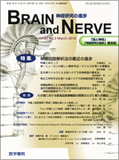Japanese
English
- 有料閲覧
- Abstract 文献概要
- 1ページ目 Look Inside
- 参考文献 Reference
はじめに
齧歯類を用いた中枢神経系の機能計測は,大別すると2種類の脳標本,すなわち,覚醒下および麻酔下のin vivo系標本と,スライス標本に代表されるin vitro系標本において行われる。In vivo系には,光や音などの自然刺激により誘発される神経活動を記録できるという極めて大きな利点がある半面,心拍や呼吸などの振動ノイズの影響を受けやすいことや,計測したい脳部位への電極アクセスが容易ではない,などの負の側面もある。他方,in vitro系の利点としては,標本に含まれる局所的な神経回路の機能を,高い信号/雑音比で,薬理学的な作用も含めて詳細に調べられる点が挙げられるが,当然のことながら,スライス標本では脳全体で構成される複雑な神経ネットワークの特性は解析し得ない。Llinásらは,このようなジレンマを解く方法として,モルモットを用いた単離脳標本の作製技術を確立した1-3)。単離脳標本とは,血管系を介した実験液の灌流により,脳全体があたかも生体中にあるかのような状態で測定チェンバー内に保持される標本である。同標本を用いれば,in vivo系のように3次元神経回路を保ちつつ,スライス標本のように心拍や呼吸の影響を受けない好条件下での神経活動計測が可能となる。特に,同標本は測定チェンバー内で脳の上下を逆転して固定できるため,辺縁系皮質を中心とした嗅球に始まる嗅覚系の神経ネットワーク(梨状皮質,扁桃体皮質,嗅内皮質)の解析に威力を発揮する。
本稿では,まず,モルモット単離脳標本の作製法と標本維持の方法について述べる。次に,同標本における電気生理学的解析により明らかとされた辺縁系の神経回路について概説する。そして最後に,筆者らが行った膜電位イメージング手法の適用例を紹介し,単離脳標本とイメージング技術の融合が,嗅覚系における辺縁系の神経回路解析において,いかに有用であるかを示したい。
Abstract
Many electrophysiological studies have been conducted on the ‘limbic system',which is known to play a crucial role in mnemonic,emotional,and olfactory functions. Because of the difficulty in accessing such deep brain structures under in vivo conditions,in vitro brain slice preparations are often used. Recently,an isolated whole brain preparation in which multi-synaptic circuits and the intracellular activity they generate are well preserved has also become available. In this paper,we described about the studies of the olfactory circuits by using this unique preparation. This experimental approach combines the advantages of the in vivo experimental condition with those of in vitro slice preparations,i.e. an intact synaptic network,excellent mechanical stability,and control over the ionic and biochemical extracellular environment. In particular,it provides easy access to the limbic system and preserves the neuronal network of the entorhinal-hippocampal loop. We used this preparation in combination with optical imaging performed using voltage-sensitive dyes in order to investigate how olfactory information is transferred from the olfactory bulb to the piriform,entorhinal and amygdaloid cortices. We visualized the propagation pattern of the neural activity after olfactory nerve stimulation and found that piriform and entorhinal activities converge in the amygdaloid cortex. This convergence may allow the amygdaloid cortex to integrate olfactory sensation with the information retained or processed in the entorhinal cortex.

Copyright © 2010, Igaku-Shoin Ltd. All rights reserved.


